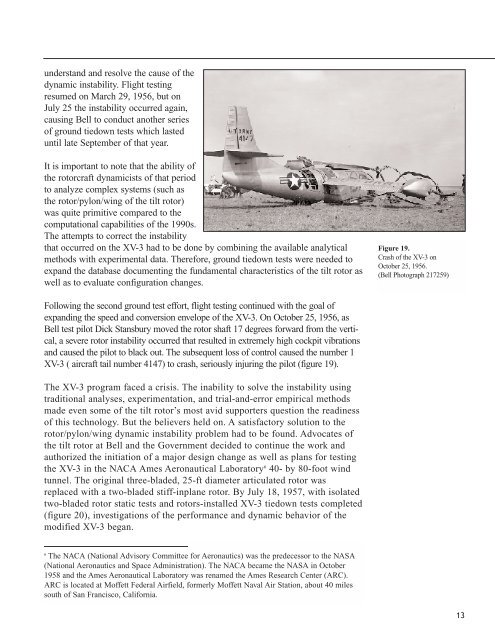XV-15 litho - NASA's History Office
XV-15 litho - NASA's History Office
XV-15 litho - NASA's History Office
You also want an ePaper? Increase the reach of your titles
YUMPU automatically turns print PDFs into web optimized ePapers that Google loves.
understand and resolve the cause of the<br />
dynamic instability. Flight testing<br />
resumed on March 29, 1956, but on<br />
July 25 the instability occurred again,<br />
causing Bell to conduct another series<br />
of ground tiedown tests which lasted<br />
until late September of that year.<br />
It is important to note that the ability of<br />
the rotorcraft dynamicists of that period<br />
to analyze complex systems (such as<br />
the rotor/pylon/wing of the tilt rotor)<br />
was quite primitive compared to the<br />
computational capabilities of the 1990s.<br />
The attempts to correct the instability<br />
that occurred on the <strong>XV</strong>-3 had to be done by combining the available analytical<br />
methods with experimental data. Therefore, ground tiedown tests were needed to<br />
expand the database documenting the fundamental characteristics of the tilt rotor as<br />
well as to evaluate configuration changes.<br />
Following the second ground test effort, flight testing continued with the goal of<br />
expanding the speed and conversion envelope of the <strong>XV</strong>-3. On October 25, 1956, as<br />
Bell test pilot Dick Stansbury moved the rotor shaft 17 degrees forward from the vertical,<br />
a severe rotor instability occurred that resulted in extremely high cockpit vibrations<br />
and caused the pilot to black out. The subsequent loss of control caused the number 1<br />
<strong>XV</strong>-3 ( aircraft tail number 4147) to crash, seriously injuring the pilot (figure 19).<br />
The <strong>XV</strong>-3 program faced a crisis. The inability to solve the instability using<br />
traditional analyses, experimentation, and trial-and-error empirical methods<br />
made even some of the tilt rotor’s most avid supporters question the readiness<br />
of this technology. But the believers held on. A satisfactory solution to the<br />
rotor/pylon/wing dynamic instability problem had to be found. Advocates of<br />
the tilt rotor at Bell and the Government decided to continue the work and<br />
authorized the initiation of a major design change as well as plans for testing<br />
the <strong>XV</strong>-3 in the NACA Ames Aeronautical Laboratory 6 40- by 80-foot wind<br />
tunnel. The original three-bladed, 25-ft diameter articulated rotor was<br />
replaced with a two-bladed stiff-inplane rotor. By July 18, 1957, with isolated<br />
two-bladed rotor static tests and rotors-installed <strong>XV</strong>-3 tiedown tests completed<br />
(figure 20), investigations of the performance and dynamic behavior of the<br />
modified <strong>XV</strong>-3 began.<br />
6 The NACA (National Advisory Committee for Aeronautics) was the predecessor to the NASA<br />
(National Aeronautics and Space Administration). The NACA became the NASA in October<br />
1958 and the Ames Aeronautical Laboratory was renamed the Ames Research Center (ARC).<br />
ARC is located at Moffett Federal Airfield, formerly Moffett Naval Air Station, about 40 miles<br />
south of San Francisco, California.<br />
Figure 19.<br />
Crash of the <strong>XV</strong>-3 on<br />
October 25, 1956.<br />
(Bell Photograph 217259)<br />
13

















